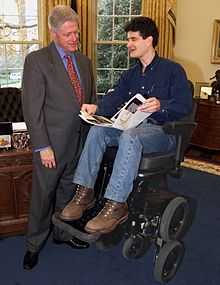IBOT

The iBOT is a powered wheelchair developed by Dean Kamen in a partnership between DEKA and Johnson and Johnson's Independence Technology division.
As of 2009, it is no longer available for sale from Independence Technology, but support for existing units will be available until the end of 2013.[1]
In 2010, one organization was trying to revive the manufacture and maintenance of the iBOT Mobility System. America's Huey 091 Foundation is an organization that provides advanced mobility devices, which used to include the iBOT, to wounded disabled veterans. The foundation's goal is to help revive the manufacture of a new generation of iBOT and if possible to manufacture, sell, and maintain some using a veteran owned and operated organization.
In 2011, Dean Kamen, the inventor of the iBOT, stated his support of America's Huey 091 Foundation's effort to reinstate iBOT production.[2]
Features
The iBOT has a number of features distinguishing it from most powered wheelchairs:
- By rotating its two sets of powered wheels about each other, the iBOT can "walk" up and down stairs, much like a cog railway or a rack and pinion with the two wheels as the "teeth" of the gear. The wheels can roll slightly at each step to compensate for a wide range of stair dimensions. When stair-climbing without assistance, the user requires a sturdy handrail and a strong grip. With an assistant, neither a handrail nor a strong grip are required.
- The iBOT is capable of tethered remote control operation, useful for loading the wheelchair up ramps into vehicles, or "parking" out of the way when not occupied.
- Custom software receives data via various sensors and gyroscopes, allowing the iBOT to maintain balance during certain maneuvers. For example during curb climbing the seat remains level while parts of the chassis tilt to climb the curb.
- It allows the user to rise from a sitting level to approximately 6' tall, measured from the ground to the top of the head, and depending on the size of the occupant (see illustration above). It does this by raising one pair of wheels above the other to elevate the chassis, while a separate actuator raises the seat slightly more than usual. In this configuration the device is on two wheels, and the 'iBALANCE' software and gyroscope signals control the iBOT to maintain equilibrium, balancing much like the Segway scooter (which was a spin-off from the iBOT development). The user may also travel in this "standing" configuration.
- It can climb and descend curbs ranging from 0.1 to 5.0 inches, according to the manufacturer's specifications. The limits are determined by the rider's technique and risk tolerance.
- It is capable of traveling through many types of terrain, including sand, gravel, and water up to 3" deep.
References
- ↑ iBot homepage, retrieved 10 Apr 2009
- ↑ "Huey091 > Home". Huey091foundation.org. 2011-12-18. Retrieved 2012-02-04.
External links
- Website with information about how to save the iBot
- Independence iBOT 4000 Mobility System
- iBot 4000 article – Note: search site for other ibot articles